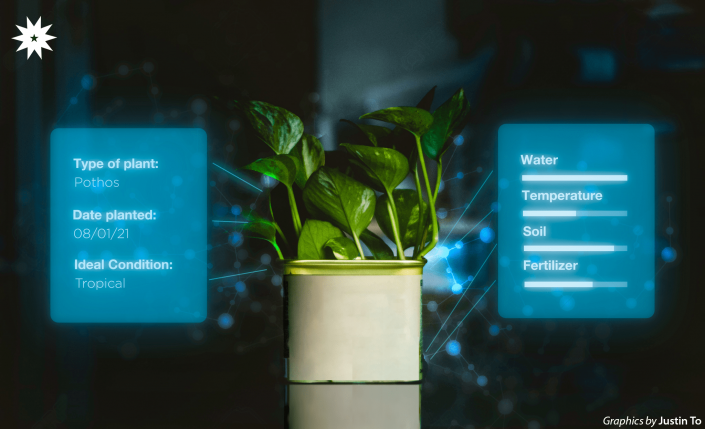Digitalization has changed the ways we live, work, and relate to one another, creating a fusion of technologies that blur the lines between digital and biological spheres. While many think of farming as a landscape of manual labor, they may be surprised by how different agricultural work is to what they imagine.
The new age of farming in the Philippines is envisioned to be a science-based industry where young Filipinos will be placed at the forefront of a technological revolution. However, enticing younger generations to pursue a career in farming may be difficult as the financial conditions of farmers have not improved in recent years.

Integrating nature and technology
Smart farming, in essence, focuses on improving agricultural efficiency through the use of technology. It seeks to “improve yield and save labor and money significantly,” explains Arsenio Barcelona, president of the Harbest Agribusiness Corporation.
Barcelona’s involvement in agriculture began after his exposure to livestock and vegetable farming in Taiwan where he saw the potential of introducing Taiwanese products and equipment to the developing market in the Philippines.
He describes a wide array of smart farming technologies such as “drones for monitoring standing crops and spraying of fertilizers, fungicides, and pesticides” and “temperature-controlled greenhouses to protect crops from extreme weather conditions.” These technologies address the growing need for monitoring crop conditions amid a changing climate.
In addition to these external tools, biotechnology such as genetic engineering allow for genetically modified organisms (GMOs). GMOs are genetically engineered plants or animals that use small amounts of genetic material from other organisms to confer pest resistance, pesticide tolerance, and other traits.
Another approach to smart farming is the use of natural and synthetic biostimulants such as extracts from algae or from other plants that enhance plant growth and stress tolerance. Barcelona adds that these advancements have paved the way for sustainability and disease resistance of crop fields.
However, these steps toward the modernization of agriculture are not without their drawbacks. Barcelona emphasizes that while smart farming is more efficient, it is not necessarily more productive. It remains highly dependent on how farmers apply these technologies.
Small-scale producers must also overcome hurdles such as poor access to information, digital illiteracy, and the high cost of smart devices before they adopt smart farming practices.
Dirt on your hands
Contrary to the popular narrative surrounding the topic, Barcelona believes that smart farming will not be substituting the country’s local farmers. “They are needed [in the industry],” the Harbest president articulates, indicating that machines and artificial intelligence will never be capable of replacing human wisdom and decision making.
Agriculture relies heavily on the personal optimization of water resources, management of climate challenges, and soil preservation—and even then, it is human knowledge of science which will allow smart technologies to develop.
Smart farming, as Barcelona likes to think, allows farmwork to be faster, easier, and more efficient. He explains that a local farmer may spray one hectare a day, whereas a drone can spray about 40. Despite this, Barcelona stresses that there are a lot of items that have to be grown by hand, “Hindi pwede machine lang lahat or robotics.”
(Not everything can be done by machines or robotics.)
In order for smart farming’s promises to be fulfilled, farmers will have to learn the skills and technology involved. While farmers with more resources are capable of affording expensive smart farming equipment, small farms may begin with hydroponic systems. For instance, a system called “deep water culture” only necessitates that the plants’ roots be directly submerged in nutrient-rich water; the setup is carried out in large containers or buckets. “When you grow lettuce with [these] systems, you do not need 1,000 square meters per 5,000 square meters [of land],” he adds.
Settling the future
With smart farming on the horizon, projects can only be as strong as their weakest link. In order to effectively adapt to smart farming in the Philippines, farmers must be trained to optimize the smart farming technologies, the government must implement practicum programs where students are being provided more than just theories, and both financial and training aids must be given to small and traditional farmers.
Barcelona proposes that farmers be provided with more accessibility to apt training and education on digital literacy, such as the Department of Agriculture’s Digital Farmers Program. Likewise, he also calls for the implementation of skill-centered agricultural courses and the rationalization of infrastructure projects, budget, and food security initiatives. “Once farmers have the conducive environment to be productive and make sufficient income, they will adapt to smart farming,” he posits.
If such support efforts for smart farming are provided, perhaps the Philippines could celebrate systems more efficient than carabaos and finally see crops which are resistant to pests, diseases, and extreme weather. Then, as new machineries enter the global and local markets, farmers are likely to diversify their approach in order to meet the needs of an ever-growing population. Currently, however, this is a future that remains far away.
